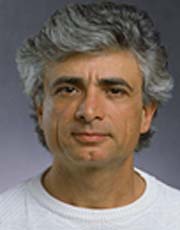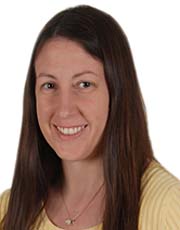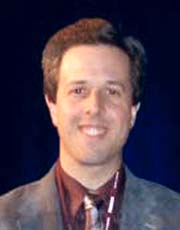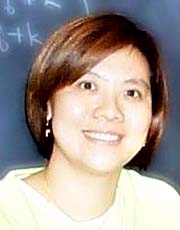Register
Click here to register on-line, and pay by credit card.
Click here to register by mail (pdf), and pay by check (deadline: received by Monday October 8).
Fall 2012 SoCal-Nev Section Meeting
California State University Long Beach
Saturday, October 13, 2012
(Directions and Map)
Tentative Program
- 8:45-11:45 Registration
Lecture Hall Building Courtyard - 8:00 -10:30 Refreshments
Lecture Hall Building Courtyard - 8:45-9:30 Graduate Students drop-off Job Application Materials for Feedback
Lecture Hall Building Courtyard - 9:00-2:30 MAA Book Sale
Lecture Hall Building Courtyard
Organized by Richard Katz and Michael Hoffman, CSU, Los Angeles - 9:00-10:00 Invited Address by Guershon Harel, U.C. San Diego.
Intellectual Need and its Application in Curriculum and Instruction
Lecture Hall - 151 - 10:00-10:10 Section Business Meeting
Lecture Hall - 151
- 10:20-11:35 Contributed Paper Session
View the call for papers
LA-5 Rooms to be announced
Organized by Steve Morics, University of Redlands - 11:40-12:40 Invited Address by Sarah Eichhorn, U.C. Irvine
Would You Like to Play a Game?
Revisiting Martin Gardner's Matchbox Game-Learning Machine
Lecture Hall - 151 - 12:40-1:50 Luncheon
Boxed Lunches provided by Subway - 1:50-2:50 Invited Address by Daphne Liu, CSU Los Angeles
From Graph Coloring to the Lonely Runner Conjecture:
A Journey of Discovery
Lecture Hall - 151 - 2:50-3:20 Refreshments
Lecture Hall Building Courtyard - 2:50-3:20 Graduate Students pick up reviewed job application materials.
Lecture Hall Building Courtyard - 3:20-4:20 Invited Address by Matt DeLong, Taylor University
Variations on Farmer Ted’s Chicken Coop:
The Story of a Natural Undergraduate Research Problem
Lecture Hall - 151
Directions and Maps
For directions, use this map to CSULB, and this interactive campus map. Look for the Lecture Hall (LH) and the LA5 building in the southern part of campus on the left.
Parking: Park in lot 6, which is located at the bottom of the map. A parking permit is required. Purchase one at the yellow dispenser.
Lunch
Lunch is a Subway box lunch, consisting of a sandwich, chips, cookies, and a soft drink or water, for $6.50. The sandwich options are: Veggie Delite, Roast Beef, Oven Roasted Chicken, Turkey Breast, and Black Forest Ham.
Hotels
CSULB lists area hotels on this site.
Register
These are coming soon. Check back after 9/19.
Click here to register on-line, and pay by credit card.
Click here to register by mail, and pay by check (deadline: received by Monday October 8).
Registration Fees
| Registration | |
| Nonmember | $45 |
| MAA Member | $40 |
| Student | $15 |
Subway box lunch |
|
| Add | $6.50 |
On-site registration will be available for the meeting, but will be $5 more than the pre-registration charge.
Guershon HarelUC San Diego |
Guershon Harel has been a Professor of Mathematics at the University of California San Diego since 2000. Prior to his tenure at UCSD he served for a decade as a faculty member at the Department of Mathematics at Purdue University. His research focuses on cognition and epistemology of mathematics and their application in mathematics curricula and teacher education. During the last two decades he has been working closely with teachers and schools and has developed a research-based conceptual framework (called DNR-based instruction in mathematics) for the learning and teaching of mathematics. The most central characteristic of DNR is that it puts the mathematical integrity of the content taught and the intellectual need of the student in the center of the instructional effort. |
Intellectual Need and its Application in Curriculum and Instruction
Years of experience with schools have left me with a strong impression that most students, even those who are eager to succeed in school, feel intellectually aimless in mathematics classes because we (teachers) fail to help them realize an intellectual need for what we intend to teach them. The main goal of the talk is to define intellectual need, discuss its manifestations in mathematical practice, and demonstrate its absence and potential presence in mathematics instruction. Examples from calculus, complex numbers, and mathematical proofs will be discussed.
Sarah EichhornUC Irvine |
Sarah Eichhorn is the Assistant Vice Chair of Undergraduate Studies in Mathematics at University of California, Irvine. Dr. Eichhorn received her Ph.D. in Applied Mathematics from the University of Arizona in 2004. Her original research area was in dynamical systems applications to planetary science and geodesy, however she has recently started dabbling in computational game theory due to the interesting, accessible undergrad research projects in this field. Dr. Eichhorn currently has several NSF undergraduate training grants which supported 40 undergraduate student researchers this past summer. Dr. Eichhorn has won several teaching awards including MAA's Alder Award for Distinguished Teaching in 2011. |
Would you like to play a game?
Revisiting Martin Gardner's Matchbox Game-Learning Machine
In 1983, the movie "WarGames" provided a dramatized look at a computer programed to learn to play games and the resulting nuclear missile scare. This sort of game learning computer program is not just science-fiction, but rather an easy to create tool, useful to game theorists (minus the nuclear missiles). In this talk, we will take a look at the Hexapawn game learning machine created in 1962 by renowned recreational mathematician Martin Gardner. In order to fully analyze his remarkable game learning machine, we will draw from results in probability, graph theory, game theory and numerical analysis. We will look at applications of this adaptive learning technique to prove results for a variety of open game theory problems.
Matt DeLongTaylor University |
Matt is a visiting professor in the Department of Mathematics at Harvey Mudd College for 2012-2013, while on sabbatical from his roles as Professor of Mathematics and Fellow of the Center for Teaching and Learning Excellence at Taylor University, in Upland, IN. He was also recently named one of the Associate Directors of the MAA’s Project NExT. Matt has a B.A. from Northwestern University and a Ph.D. from the University of Michigan. He was awarded the 2005 Alder Award and the 2012 Haimo Award for distinguished teaching from the MAA. |
Variations on Farmer Ted’s Chicken Coop:
The Story of a Natural Undergraduate Research Problem
The problem of minimizing the perimeter of a rectangle of a given area is familiar to all introductory calculus students. Its solution was not at all natural, however, to Farmer Ted, a fictitious character introduced by G. Martin in a 1999 Mathematics Magazine article, who required integer solutions to his farming needs. To help Farmer Ted build his coop, Martin’s article defined and characterized what he called almost-squares. Two undergraduate students of mine, Alspaugh and Cooper, wrote follow-up papers in the Magazine, in which they helped Farmer Ted by generalizing Martin’s work to three dimensions and to weighted sides, respectively. In this talk I will share the mathematics of, as well as the story behind, these cute problems. I will also discuss some lessons learned from directing undergraduate research, and tell you why my Erdös number is not exactly four.
Daphene LiuCSU Los Angeles |
Daphne Liu joined the CSULA faculty in 1991 and is currently the graduate advisor for the mathematics department. She enjoys teaching and research deeply. Her research interests include graph theory and its relations to number theory and topology. Liu has received several teaching and research awards including the CSULA Outstanding Professor Award and the Innovative Teaching Award. With more than 40 published research articles, she was the principal investigator for two NSF multi-year research grants. Prior to CSULA, Liu got her Ph.D. from the University of South Carolina, Columbia, and her BS from the National Central University, Taiwan, and held research and visiting scholar positions at the Academia Sinica, Taiwan. |
From Graph Coloring to the Lonely Runner Conjecture:
A journey of discovery
Suppose k runners are running laps on a circular field of circumference m, say 400 meters. Each runner runs in a constant speed, and all speeds are distinct. The lonely runner conjecture asserts that for each runner there exists some moment that he or she becomes lonely, that is, at least m/k distance apart from other runners [Wills 1952, Goddyn 1998]. While it has been only confirmed for
k ≤ 7, the parameter involved in the conjecture has been investigated extensively by researchers in number theory, geometry, and graph theory. In this talk, we introduce amazing connections between this parameter and graph coloring parameters for distance graphs, a notion motivated by the plane coloring problem and introduced by Eggleton, Erdős, and Skilton in the mid-80’s. We also see recent results on how these relations are utilized to solve open problems. In addition, the speaker will share her experience of conducting successful undergraduate and graduate research projects on this topic.
Contributed Paper Session
Faculty and students (undergraduate and graduate) are invited to submit short proposals for 15-minute talks in the Contributed Paper Session of the Fall Meeting.
All proposals will be considered. The selection of talks will be based on interest to the expected audience, on common themes with other submissions, and on scheduling constraints. Since space and time are limited, acceptance may be prioritized based on the status of the speaker; first undergraduates, then graduate students, retirees, and faculty in order of rank.
Submissions for all contributed papers should contain a title, an abstract (not to exceed one-half page in 12-point font and suitable for inclusion in the conference program), the desirable mathematical background of the audience, and any special presentation display needs.
Ideally abstracts should be submitted in LaTex format, with an accompanying PDF file. If you do not use LaTex, please submit a Text document together with a PDF file. Please email all submissions to Steven Morics.
Each room will have a built-in projector for computers as well as a traditional overhead projector. If you require a document camera or a computer, please say so in your proposal and we will work with you to obtain one.
The submission deadline is noon on Monday, October 1, 2012.
CV, Research and Teaching Statement
Review for Graduate Students
Are you a graduate student or postdoc applying for faculty positions or other jobs this year?
Bring hard copies of your CV, Research Statement and/or Teaching Statement to the Fall Section meeting for review by a group of local mathematicians. They will help you look for ways to improve your application, so it is more competitive on the job market. To participate, please leave your materials at the registration table before 9:30 am, and they will be reviewed and ready for pick up around 3pm. You may bring academic and industrial CVs, which highlight different relevant achievements. The reviewers will return an evaluation rubric and feedback on the content and the presentation of your materials.
We wish you good luck in your job hunt!
